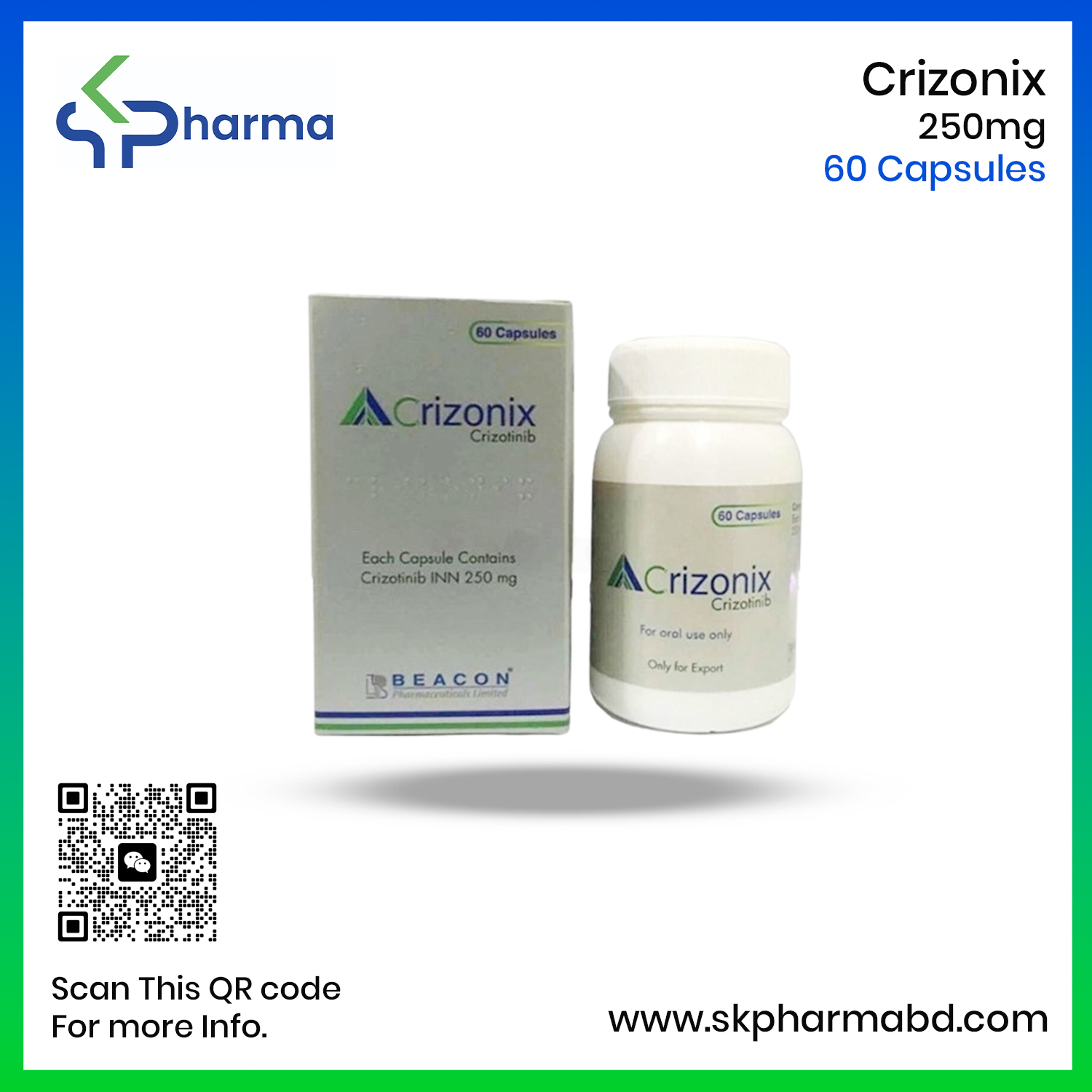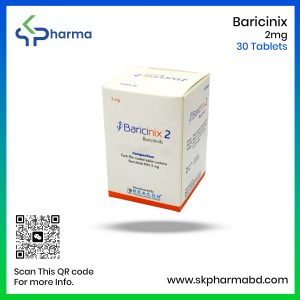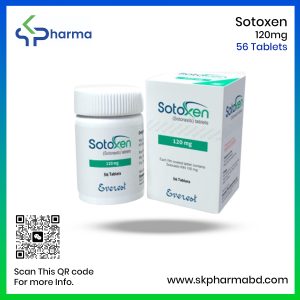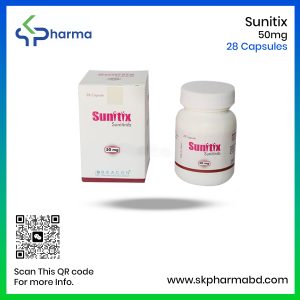Crizonix 250 Mg (Crizotinib)
Related products
Product Description
Crizonix 250 mg (Crizotinib)
Crizotinib is a kinase inhibitor indicated for the treatment of patients with locally advanced or metastatic non-small cell lung cancer (NSCLC) that is anaplastic lymphoma kinase (ALK)-positive or ROS 1 positive. Crizotinib is the first FDA-approved biomarker-driven therapy for both ALK-positive and ROS1-positive metastatic NSCLC. It is the only FDA-approved drug for ROS 1-positive NSCLC.
Indication: CRIZONIX i is indicated for the first-line treatment of adults with ALK-positive advanced NSCLC and for the treatment of adults with previously treated ALK-positive advanced NSCLC & ROS1 ( ) NSCLC. Crizotinib is an ALK and ROS1 (c-ros oncogene 1, receptor tyrosine kinase) inhibitor.
Product Features:
Product Name : Crizonix
Generic Name : Crizotinib
Formulation: Capsule
Available Pack Size: 28’s & 60’S
Available Strengths: 250mg
Categories: Oncology
Manufacturer: Beacon Pharmaceuticals Ltd.
Indications
Crizotinib is a kinase inhibitor indicated for the treatment of patients with-
Metastatic non-small cell lung cancer (NSCLC) whose tumors are anaplastic lymphoma kinase (ALK)-positive
Metastatic NSCLC whose tumors are ROS1-positive
*Take according to the doctor’s advice
Therapeutic Class
Targeted Cancer Therapy
Description
Crizotinib is a kinase inhibitor indicated for the treatment of patients with locally advanced or metastatic non-small cell lung cancer (NSCLC) that is anaplastic lymphoma kinase (ALK)-positive or ROS 1 positive. Crizotinib is the first FDA-approved biomarker-driven therapy for both ALK-positive and ROS1-positive metastatic NSCLC. It is the only FDA-approved drug for ROS 1-positive NSCLC.
Pharmacology
Crizotinib is an inhibitor of receptor tyrosine kinases including ALK, Hepatocyte Growth Factor Receptor (HGFR, c-Met), ROS1 (c-ros), and Recepteur d’Origine Nantais (RON). Translocations can affect the ALK gene resulting in the expression of oncogenic fusion proteins. The formation of ALK fusion proteins results in activation and dysregulation of the gene’s expression and signaling which can contribute to increased cell proliferation and survival in tumors expressing these proteins. Crizotinib demonstrated concentration-dependent inhibition of ALK, ROS1, and c-Met phosphorylation in cell-based assays using tumor cell lines and demonstrated antitumor activity in mice bearing tumor xenografts that expressed echinoderm microtubule-associated protein-like 4 (EML4)- or nucleophosmin (NPM)-ALK fusion proteins or c-Met.
Dosage & Administration
Recommended Dose: 250 mg orally, twice daily
Geriatric Use: No differences in safety or efficacy were observed between older and younger patients. Clinical studies of Crizotinib in patients with ROS1-positive metastatic NSCLC did not include sufficient numbers of patients aged 65 years and older to determine whether they respond differently from younger patients
Pediatric Dose: The safety and effectiveness of Crizotinib in pediatric patients have not been established.
Renal impairment: 250 mg orally, once daily in patients with severe renal impairment (creatinine clearance <30 mL/min) not requiring dialysis. No starting dose adjustment is needed for patients with mild (ClCr 60-89 mL/min) or moderate (ClCr 30-59 mL/min) renal impairment based on a population pharmacokinetic analysis.
Hepatic Impairment: Caution should be used in patients with hepatic impairment
*Take according to the doctor’s advice
Interaction
CYP3A Inhibitors: Concurrent use of Crizotinib should be avoided with strong CYP3A inhibitors including but not limited to atazanavir, clarithromycin, indinavir, itraconazole, ketoconazole, nefazodone, nelfinavir, ritonavir, saquinavir, telithromycin, troleandomycin, and voriconazole
CYP3A Inducers: Concurrent use of Crizotinib should be avoided with strong CYP3A inducers including but not limited to carbamazepine, phenobarbital, phenytoin, rifabutin, rifampin, and St. John’s Wort
CYP3A Substrates: Concurrent use of Crizotinib should be avoided with CYP3A substrates with narrow therapeutic indices including but not limited to alfentanil, cyclosporine, dihydroergotamine, ergotamine, fentanyl, pimozide, quinidine, sirolimus, and tacrolimus
Side Effects
The most common adverse reactions (≥25%) are vision disorders, nausea, diarrhea, vomiting, edema, constipation, elevated transaminases, fatigue, decreased appetite, upper respiratory infection, dizziness, and neuropathy.
Pregnancy & Lactation
Based on its mechanism of action, Crizotinib can cause fetal harm when administered to a pregnant woman. There are no available data on the use of Crizotinib during pregnancy. Females of reproductive potential should be advised of the potential risk to a fetus and the use of effective contraception.
There is no information regarding the presence of Crizotinib in human milk, the effects on the breastfed infant, or the effects on milk production. Because of the potential for adverse reactions in breastfed infants patients should not breastfeed during treatment with Crizotinib and for 45 days after the final dose.
Precautions
Hepatotoxicity: Patients should undergo periodic liver testing. Crizotinib should be temporarily suspended, dose reduced, or permanently suspended
Interstitial lung disease (ILD)/ Pneumonitis: The drug should be permanently discontinued in patients with ILD/ Pneumonitis
QT interval prolongation: Electrocardiograms and electrolytes in patients who have a history of or predisposition for QTc prolongation, or who are taking medications that prolong QT should be monitored. Crizotinib should be temporarily suspended, dose reduced, or permanently suspended
Bradycardia: Crizotinib can cause bradycardia. Heart rate and blood pressure should be regularly monitored. Crizotinib should be temporarily suspended, dose reduced, or permanently suspended
Severe visual loss: Ophthalmological evaluation should be performed. Crizotinib should be discontinued in severe visual loss
Embryo-fetal toxicity: Crizotinib can cause fetal harm. Females of reproductive potential should be advised of the potential risk to a fetus and the use of effective contraception






